Old Essex County Jail
Introduction
Text-to-speech Audio
Images
Photo of main side of jail complex in 1967 behind white picket fence & stone wall, by George Eisenman (HABS NJ-758)
.%20loc.jpg)
Jail complex (green arrow) behind stone (blue) walls on 1892 Sanborn map (V. 2 p. 134)
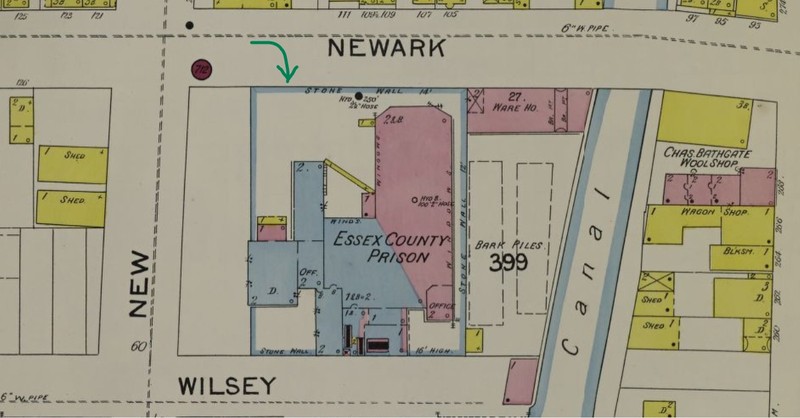
Main entrance to jail complex in 1967 HABS photo (Eisenman)
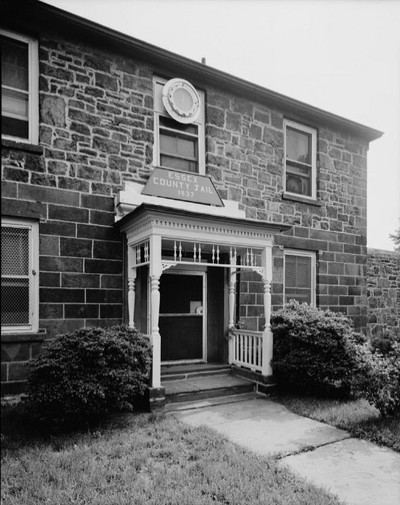
Plan sketch of all 10 buildings in jail complex in 1990 for NRHP (Zakalak)
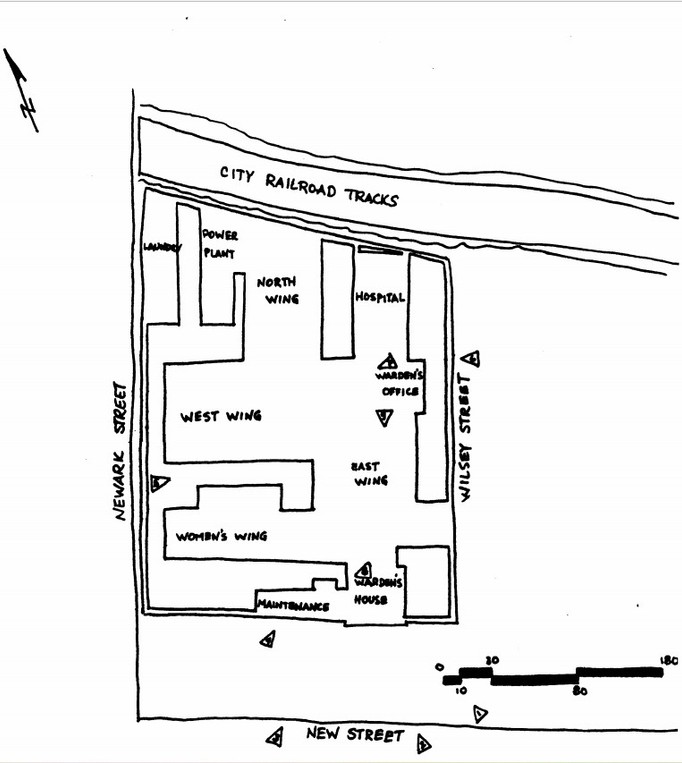
Essex County Jail complex (red arrow) on 1895 map of Newark (Harrison-Kearney)
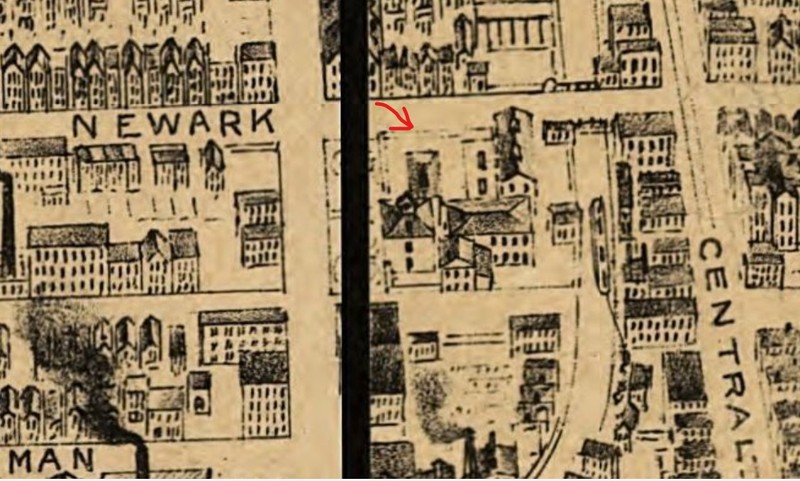
View of two stone buildings in the complex from the jail yard in 1967 HABS photo (Eisenman)
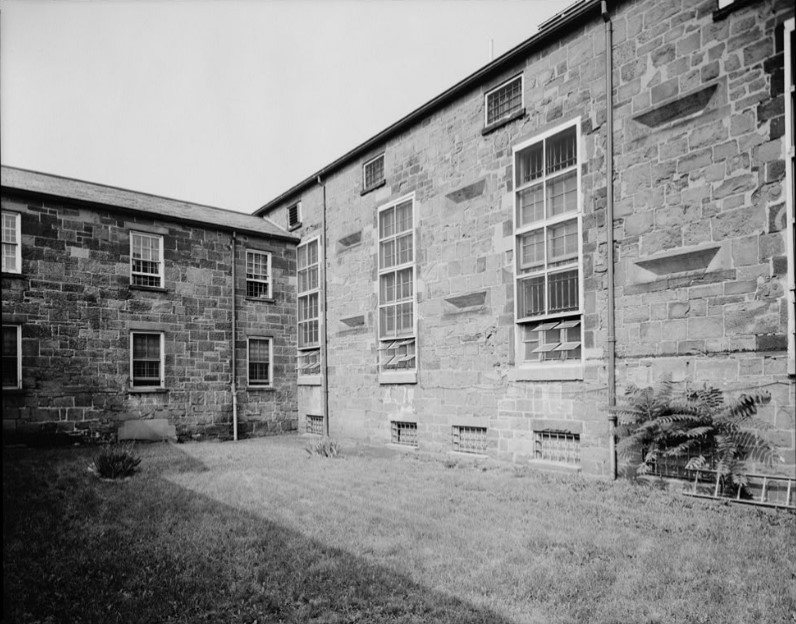
View of interior of abandoned jail cellblock in 1990 photo for NRHP nomination (Gerry Weinstein)
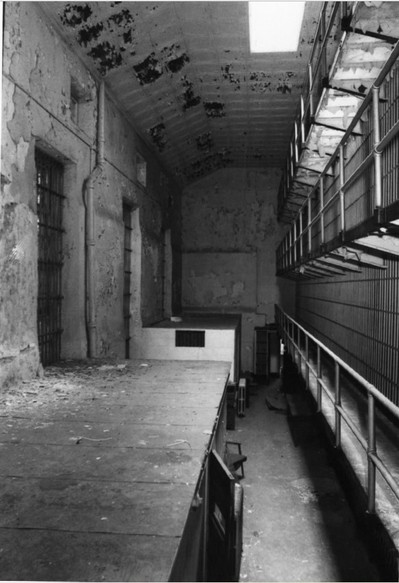
Backstory and Context
Text-to-speech Audio
The third (top) floor and basement of the 1810 former courthouse for Essex County contained prison cells. This former building was located south of Broad Street and burned down in 1835; Grace Church stands there now, and the basement dungeon remains. When a new courthouse was designed in the mid-1830s for a spot near the north end of Market Street (demolished ca. 1901), the same architect also created plans for a new jail at the current location of the county jail complex ruins (this Clio entry). The original architect of the jail, the Englishman John Haviland, also designed the infamous Eastern State Penitentiary in Philadelphia and the New Jersey State Prison in Trenton. The jail's design was influenced by the prison reform movement, where prisoners were isolated and rehabilitated to encourage penitence over punishment; skylights and large, barred windows brought in natural light. The original complex consisted of the Warden's House and a single cellblock, surrounded by a 12-foot tall wall; all were made from locally-quarried sandstone.
Over time, a power plant, hospital, laundry, and garage were added to the prison complex, which expanded to cover 1.5 acres. The jail complex featured electricity, running water and sewer, and heat in the nineteenth century when many jails did not have such luxuries. The complex once held a greenhouse that inmates with a history of good behavior could enjoy, along with a courtyard and walking paths. The warden and his family lived and worked in the complex, too. The environment in the latter half of the nineteenth century was not all that pleasant, however, with the noxious odors from the nearby tanning and leather industries along the Morris Canal. The addition of three more wings in the 1890s and early twentieth century gave the stone and brick complex behind the towering stone walls an overall plan resembling a pinwheel.
The Old Essex County Jail was the subject of a HABS photographic study in 1967, while it was still the county's main jail complex. A newer jail was built elsewhere in the county and opened in 1970. The Essex County Narcotics Bureau used the former prison complex to interview informants, so they would not be seen entering the courthouse. Some confidential records were left behind in storage when the building was finally abandoned in 1989; confiscated gambling machines were left here, too. The complex is still owned by the City of Newark, 30 years later. The warden's house has collapsed from abandonment and neglect, and the roofs of the other structures have gaping holes. Some have called for the litter and debris-filled buildings to be demolished; a science park was going to take its place in 2010 but the plans were not approved. Rutgers U. Law students have applied for the complex to be removed from the National Register.
Adaptive reuse plans have been proposed by Columbia University graduate students in recent years as part of a 2018 course taught by architects Belmont Freeman and Bryony Roberts. The historical and architectural research plus proposals by the eleven students in the Graduate School of Architecture, Planning & Preservation are part of an online exhibit (linked below). One of the plans called for institutional reuse of the complex by the neighboring New Jersey Institute of Technology's School of Art & Design. That plan would preserve the skeleton of the existing buildings in the complex to be adapted into new buildings while adding a new, eight-story building; the outdoor spaces would become exhibit spaces for sculpture. Another proposal was to turn the complex into housing as a hostel. Steel cells in the jail's North and East Wings would become guest rooms or be combined to form apartments; masonry cells in the West Wing would be removed to create reception space, a lounge, and a cafe. The engineering room would become a gym and the Warden's House would be office and exhibit space for the Newark Landmarks organization.
Sources
--, Alexander. The abandoned Essex County Jail of New Jersey, Deserted Places blog. November 14th 2016. Accessed January 24th 2021. https://desertedplaces.blogspot.com/2016/11/the-abandoned-essex-county-jail-of-new.html.
--, Kristen. The Remnants of This Abandoned Prison in New Jersey Are Hauntingly Beautiful, Only in Your State. New Jersey. June 15th 2017. Accessed January 24th 2021. https://www.onlyinyourstate.com/new-jersey/abandoned-prison-ruins-nj/.
Eisenman, George. HABS photographs of Essex County Jail, Newark, New and Halsey Streets, Newark, N.J.. HABS NJ-758. Historic American Buildings Survey. Washington, DC. Department of the Interior, 1967.
Gaikwad, Shivali. Zhang, Myles. Institutional Reuse, Old Essex County Jail, future reuse proposals. January 3rd 2019. Accessed January 25th 2021. https://www.oldessexcountyjail.org/2019/01/03/shivali-gaikwad/.
Kirsch, Thomas. Old Essex County Jail. Solitude, Opacity. November 30th 2004. Accessed January 24th 2021. https://opacity.us/gallery32_solitude.htm.
Yu, Qianye. Zhang, Myles. Housing, Old Essex County Jail, future reuse proposals. January 7th 2019. Accessed January 25th 2021. https://www.oldessexcountyjail.org/2019/01/0y/qianye-yu/.
Zakalak, Ulana D. NRHP Nomination of (Old) Essex County Jail, National Register of Historic Places. August 15th 1990. Accessed January 25th 2021. https://npgallery.nps.gov/AssetDetail/NRIS/91001366.
Zhang, Myles. Jail Construction Materials and Technology, Old Essex County Jail. January 1st 2019. Accessed January 25th 2021. https://www.oldessexcountyjail.org/construction-materials-technology/.
Zhang, Myles and Zemin. Professors' Introduction, Old Essex County Jail. January 1st 2019. Accessed January 25th 2021. https://www.oldessexcountyjail.org/2019/01/01/professors-introduction/.
Zhang, Myles and Zemin. Origins of the Essex County Jail, Old Essex County Jail. January 1st 2019. Accessed January 25th 2021. https://www.oldessexcountyjail.org/john-haviland-and-essex-county-jail/.
https://www.loc.gov/item/nj0046/
https://www.loc.gov/item/sanborn05571_002/
https://www.loc.gov/item/nj0046/
https://www.loc.gov/item/75694732/
https://www.loc.gov/item/nj0046/
https://npgallery.nps.gov/AssetDetail/NRIS/91001366
